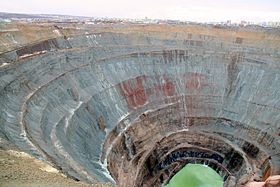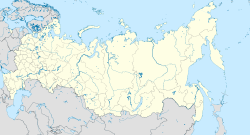- Mir mine
-
Mir Mine
The Mir mine in YakutiaLocation Location in Russia 62°31′45.92″N 113°59′36.74″E / 62.5294222°N 113.9935389°ECoordinates: 62°31′45.92″N 113°59′36.74″E / 62.5294222°N 113.9935389°E
Location Mirny Region Siberia Country Russia Owner Company Alrosa Website http://www.alrosa.ru/about/structure/171/mirninsky_gok/ Year of acquisition 1992 Production Products Diamonds Production 10,000,000 carats (2,000 kg) per year Financial year 1960s History Opened 1957 Closed 2001 Mir Mine (Russian: Кимберлитовая алмазная трубка «Мир» Kimberlitovaya Almaznaya Trubka "Mir"; English: kimberlite diamond pipe "Peace") also called Mirny Mine is an open pit diamond mine located in Mirny, Eastern Siberia, Russia. The mine is 525 meters (1,722 ft) deep (4th in the world) and has a diameter of 1,200 m (3,900 ft),[1] and is the second largest excavated hole in the world, after Bingham Canyon Mine. The airspace above the mine is closed for helicopters because of a few incidents in which they were sucked in by the downward air flow.[2][3][4][5]
The mine was discovered on June 13, 1955 by Soviet geologists Yuri Khabardin, Ekaterina Elagina and Viktor Avdeenko during the large Amakinsky Expedition in Yakut ASSR. They found traces of volcanic rock kimberlite which are usually associated with diamonds. This finding was the first success in the search for kimberlite in Russia, after numerous failed expeditions of the 1940s and 1950s. For this discovery, in 1957 Khabardin was given the Lenin Prize, which was one of the highest awards in the Soviet Union.[6][7]
The development of the mine had started in 1957 in extremely harsh climate conditions. Seven months of winter per year froze the ground, which was hard in winter, but turned into sludge in summer. Buildings had to be raised on piles, so that they would not sink in summer, and the main processing plant had to be built on a better ground found 20 km away from the mine. The winter temperatures were so low that car tires and steel would shatter and oil would freeze. During the winter, the workers used jet engines to defreeze and dig out the permafrost or blasted it with dynamite to get access to the underlying kimberlite. The entire mine had to be covered at night to prevent the machinery from freezing.[2][8]
In the 1960s the mine was producing 10,000,000 carats (2,000 kg) of diamond per year, of which a relatively high fraction (20%) were of gem quality.[2] The upper layers of the mine (down to 340 meters) had very high diamond content of 4 carats (0.80 g) per tonne of ore, with the relatively high ratio of gems to industrial stones. The yield decreased to about 2 carats (0.40 g) per tonne and the production rate slowed to 2,000,000 carats (400 kg) per year near the pit bottom. The largest diamond of the mine was found on 23 December 1980; it weighed 342.5 carats (68 g) and was named "26th Congress CPSU" (Russian: XXVI съезд КПСС). The mine operation was interrupted in 1990s at a depth of 340 m after the pit bottom became flooded but resumed later.[9][10]
The rapid development of the Mir mine had worried De Beers company, which at that time was distributing most of the world's diamonds. De Beers had to buy Russian diamonds in order to control the market price, and therefore needed to know as much as possible about the Russian mining developments. In the 1970s, De Beers requested permission to visit the Mir mine. Permission was granted under condition that Russian experts would visit De Beers diamond mines in South Africa. De Beers executive Sir Philip Oppenheimer and chief geologist Barry Hawthorne arrived in Moscow in the summer of 1976. They were intentionally delayed in Moscow by arranging a series of meetings and lavish banquets with Soviet geologists, mineralogists, engineers and mine managers. When Oppenheimer and Hawthorne finally reached the Mir mine, their visas were about to expire, so that they could only have 20 minutes at the Mir mine. Even that short time was sufficient to get some important details. For example, the Russians did not use water during the ore processing at all, which was astonishing to De Beers. The reason was that water would freeze most of the year, and dry crushing was used instead. De Beers also overestimated the size of the mine's pit.
The Mir mine was the first and the largest diamond mine in the Soviet Union.[11] Its surface operation lasted 44 years, finally closing in June 2001.[10] After the collapse of the USSR, in the 1990s, the mine was operated by the Sakha diamond company, which reported annual profits in excess of $600 million from diamond sales.[12]
Currently, the mine is operated by Alrosa, the largest diamond producing company in Russia, and employs 3600 workers. It has long been anticipated that the recovery of diamonds by conventional surface methods will saturate. Therefore, in 1970s construction has started of a network of underground tunnels for diamond recovery. Production of diamonds by this method started in 1999 and is estimated to last for another 27 years. This estimate is based on depth explorations down to 1220 meters. In order to stabilize the abandoned main pit, its bottom was covered by a rubble layer 45 meters thick.[1]
See also
References
- ^ a b "Mirninsky GOK" (in Russian). http://www.alrosa.ru/about/structure/171/mirninsky_gok/. Retrieved 2009-08-08. English version
- ^ a b c "A Brief History of the World’s Largest Open Pit Diamond Mine". http://www.abazias.com/diamondblog/diamond-industry/a-brief-history-of-the-worlds-largest-open-pit-diamond-mine. Retrieved 2009-08-08.
- ^ "Mirny Diamond Mine". http://engagementrings.lovetoknow.com/wiki/Mirny_Diamond_Mine. Retrieved 2009-08-08.
- ^ "Mirny Diamond Mine". http://atlasobscura.com/places/mirny-diamond-mine. Retrieved 2009-08-08.
- ^ "Holes Diamond Engagement Rings Come From". 23 October 2008. http://www.diamonds-usa.com/blog/index.php/2008/10/holes-diamond-engagement-rings-come-from/. Retrieved 2009-08-08.
- ^ "Первооткрывателю трубки "Мир" Екатерине Елагиной исполняется 80 лет" (in Russian). http://1sn.ru/show.php?id=5215.
- ^ "Город Мирный" (in russian). Official site of town Mirny. http://gorodmirny.ru/info/about.html. Retrieved 2009-08-08.
- ^ E. J. Epstein (1982). "17 The Russians are coming". The diamond invention. Hutchinson. ISBN 0091476909. http://www.edwardjayepstein.com/diamond/chap17.htm.
- ^ "Именные алмазы (list of named diamond)" (in Russian). http://www.alrosa.ru/about/production/diamonds/name/index.php?sphrase_id=16613. Retrieved 2009-08-08. English version
- ^ a b Jessica Elzea Kogel, Society for Mining, Metallurgy, and Exploration (U.S.). SME. 2006. p. 424. ISBN 0873352335. http://books.google.com/books?id=zNicdkuulE4C&pg=PA424.
- ^ "The Nature of Diamonds - Russia". American Museum of Natural History. http://www.amnh.org/exhibitions/diamonds/russia.html. Retrieved 2009-08-08.
- ^ John Tichotsky. Routledge. 2000. p. 337. ISBN 9057024209. http://books.google.com/books?id=F7N4G_wxkUYC&pg=PA333.
External links
Categories:- Diamond mines in Russia
- Economy of the Soviet Union
- Economy of Siberia
- Science and technology in the Soviet Union
- Surface mines in Russia
- Diatremes of Russia
Wikimedia Foundation. 2010.


